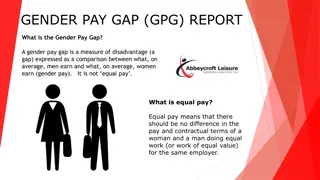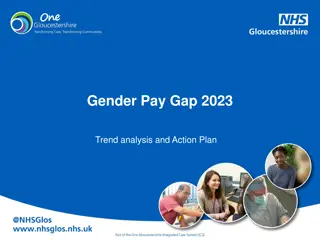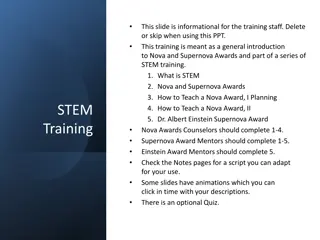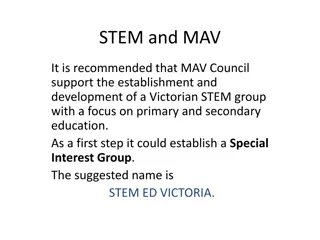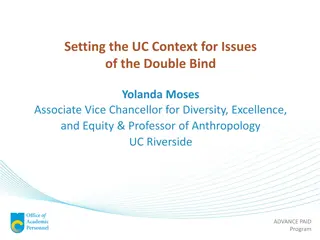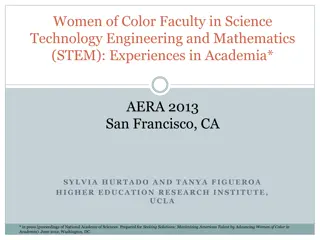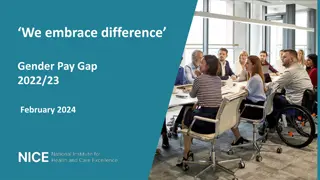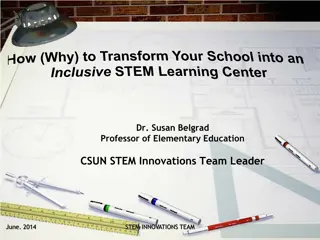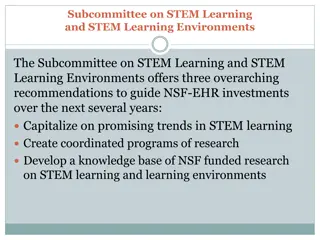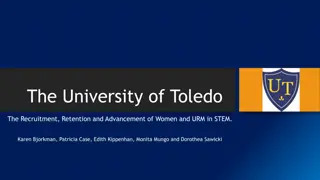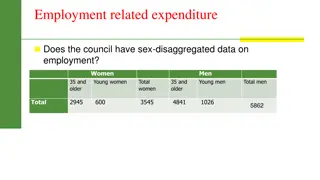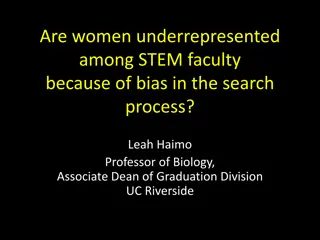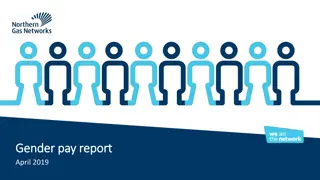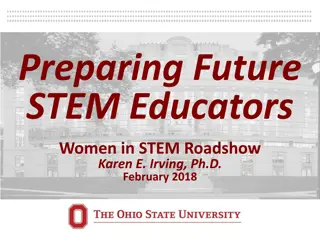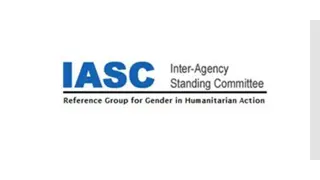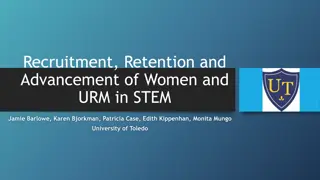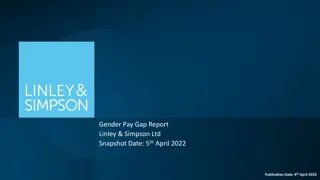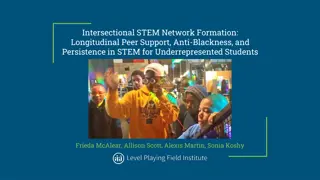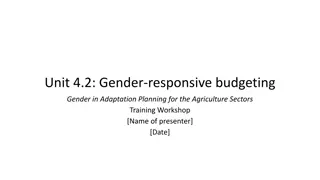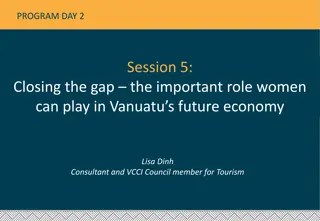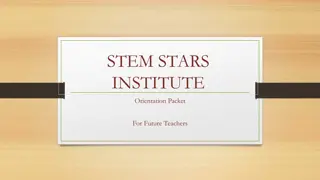Addressing the Gender Gap in STEM Majors: Insights from Leading Women
Successful women leaders in science and engineering are collaborating with informal science organization leaders to address the gender gap in STEM majors. They aim to encourage girls to enroll and persist in STEM K-15 curricula, fostering a sense of belonging in technology and engineering disciplines. Key facts illustrate the progress made in female participation in various fields, while emphasizing the need to continue advancing gender equity in STEM education. Michelle Obama's call to open doors for women and girls in STEM underscores the importance of inclusivity for innovation and education.
Download Presentation

Please find below an Image/Link to download the presentation.
The content on the website is provided AS IS for your information and personal use only. It may not be sold, licensed, or shared on other websites without obtaining consent from the author. Download presentation by click this link. If you encounter any issues during the download, it is possible that the publisher has removed the file from their server.
E N D
Presentation Transcript
How CA Leading Women Can Address the Gender Gap in STEM Majors A Conversation about Gender Equity led by: Susan Belgrad, California State University Northridge with: Janet Yamaguchi Discovery Science Cube LA Karen Latuner , California Project Lead the Way Paula Hodge, College of the Canyons, Doing What Matters
Susan Belgrad, Convener, is Professor of Education at California State University, Northridge Paula Hodge, South Coast Regional Director Doing What Matters College of the Canyons Janet Yamaguchi, Vice President of Education Discovery Science Center Karen Latuner is the School Engagement Director for Project Lead the Way , California
Leading Women Address the Gender Gap in STEM Majors Technology, computer science and engineering enrollments continue to reflect girls perception that engineering coursework is for boys. In an effort to address this, successful women leaders in science and engineering, together with informal science organization leaders, seek to identify ways in which girls enroll and remain in STEM K-15 curricula--achieving a sense of belonging in the T and E of STEM disciplines.
Leading Women Address the Gender Gap in STEM Majors If we re going to out-innovate and out- educate the rest of the world, we ve got to open doors for everyone. We need all hands on deck, and that means clearing hurdles for women and girls as they navigate careers in science, technology, engineering, and math. -- First Lady Michelle Obama, September 26, 2011
Leading Women Address the Gender Gap Key Facts about the Gender Gap in Science We have come a long way but we still have a ways to go . Percent of Females Earning Degrees in 1970 and 2012 Law School 5% (1970) to 53% (2012) Business School 4% (1970) to 40% (2012) Medical School 8% (1970) to 49% (2012) Engineering (BS) < 1% (1970) to < 20% (2012) Computer Science (BS) < 2% (1970) to < 20% (2012) Math and Physical Sciences (BS) < 15% (1970) to 40% (2012)
Leading Women Address the Gender Gap Key Facts about the Gender Gap in Tech By 2020, the US Department of Labor predicts that 1.4 million jobs will be created in the computing related fields, but U.S. graduates are only on pace to filling 29% of them. At current rates, women educated in the US will fill just 3%. In 1984, women earned 37% of all computer science bachelors degrees, but today that number has plummeted to 12%. Though women make 85% of all consumer purchases, they make up just 25% of the computing workforce.
Leading Women Address the Gender Gap Girls Who Code for example is addressing the gender gap head on by giving young women a positive experience with computer science that will impact their education and career decisions down the road. |
Leading Women Address the Gender Gap Key Facts about the Gender Gap in Engineering Some areas of science do attract more women than men, such as biology and social and behavioral sciences. But computer science, physics and engineering are overwhelmingly male. Nowhere is that disparity more pronounced than in engineering, with computer science close behind. More than twice as many men than women attend graduate school for computer science fields, and more than four times as many men are enrolled in engineering, according to the report.
Leading Women Address the Gender Gap Op-Ed Solve this math problem: The gender gap Girls are succeeding at the highest levels in math at far higher rates today than in previous generations, suggesting there is nothing intrinsically non- mathematical about being female. And girls raised in cultures with strong traditions in problem-solving competitions do much better in mathematics competitions than girls from cultures without such traditions. In the USA Math Olympiad, almost all of the girls who have won have been foreign- born, Asian American or home schooled groups that place a high emphasis on mathematics (Su, 2014).
Leading Women Address the Gender Gap In California, high school and college graduation rates are higher for women than men; however, ethnic disparities persist. In addition, women and girls have been consistently underrepresented in science, technology, engineering and mathematics (STEM) courses, resulting in a trajectory for fewer women into STEM classrooms, degrees and careers. https://encrypted-tbn1.gstatic.com/images?q=tbn:ANd9GcQd5pcZR61ohNKB_EkD28tdWia1j4xlG3utg3xIOSKrFFPkFUB9 The unemployment rate is similar among the genders; however, women are less likely to enter the workforce and when they do, they make less money than men. While STEM fields generally represent some of the highest-paying career opportunities, women are vastly underrepresented in these professions. In general, women tend to occupy positions in the lower ranks of most professional categories and are concentrated in lower-paying fields (MSMCLA,2014).
Leading Women Address the Gender Gap in STEM Supporting women STEM students is not only an essential part of America s strategy to out-innovate, out- educate, and out-build the rest of the world; it is also important to women themselves. And STEM careers offer women the opportunity to engage in some of the most exciting realms of discovery and technological innovation. Increasing opportunities for women in these fields is an important step towards realizing greater economic success and equality for women across the board. Whitehouse Office of Science and Technology http://www.whitehouse.gov/administration/eop/ostp/women
Leading Women Address the Gender Gap in STEM Majors Conversation 1 What are the awareness strategies that you have found to make a difference for girls belief that they canseek achievement in STEM-focused academic pathways that give them entry to high knowledge-high talent careers? Have you developed K-12 strategies and/or materials that raise their awareness? Have you developed materials that raise girls parents awareness of opportunities in STEM majors and careers?
Leading Women Address the Gender Gap in STEM Majors Conversation 2 Have you found mentoring strategies that directly address stereotyping or stereotype threat that offer girls effective ways to become aware of and negate their own stereotypical thinking? Have you found ways to assure that girls develop the mindset to achieve and maintain STEM-focused academic pathways and careers?
Leading Women Address the Gender Gap in STEM Majors Conversation 3 Have you found ways for women who have succeeded in STEM careers to directly work as mentors who inspire girls to feel welcome and respected in STEM majors and industry?
https://encrypted-tbn1.gstatic.com/images?q=tbn:ANd9GcQd5pcZR61ohNKB_EkD28tdWia1j4xlG3utg3xIOSKrFFPkFUB9https://encrypted-tbn1.gstatic.com/images?q=tbn:ANd9GcQd5pcZR61ohNKB_EkD28tdWia1j4xlG3utg3xIOSKrFFPkFUB9 Thank you for Participating! Susan.belgrad@csun.edu


